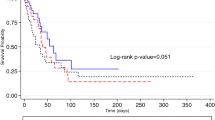Abstract
Healthcare-associated pneumonia (HCAP) is a newly identified condition, and epidemiologic studies in Japan are still limited. We retrospectively observed patients with HCAP and community-acquired pneumonia (CAP) who were hospitalized between December 2004 and March 2005, and compared their disease characteristics. A total of 34 patients (14 with HCAP and 20 with CAP) were evaluated. Of the patients with HCAP, seven (50%) were hospitalized for at least 2 days in the preceding 90 days and five (35.7%) resided in a nursing home or extended care facility. Compared with patients with CAP, patients with HCAP were older, had more complications, including central nerve diseases, had greater disease severity, but lower serum albumin level. More methicillin-resistant Staphylococcus aureus, Pseudomonas spp., and anaerobes were isolated from patients with HCAP than from those with CAP. Conversely, more Streptococcus pneumoniae was detected and more penicillin was used in patients with CAP. This study provides additional evidence that HCAP should be distinguished from CAP and suggests the pathogenesis and therapeutic strategy for HCAP may be similar to those for hospital-acquired pneumonia.
Similar content being viewed by others
Abbreviations
- A-DROP:
-
Age, dehydration, respiratory failure, orientation disturbance, low blood pressure
- ATS:
-
American Thoracic Society
- CAP:
-
Community-acquired pneumonia
- CI:
-
Confidence interval
- ESBL:
-
Extended-spectrum β-lactamase
- HAP:
-
Hospital-acquired pneumonia
- HCAP:
-
Healthcare-associated pneumonia
- IDSA:
-
Infectious Diseases Society of America
- I-ROAD:
-
Immunodeficiency, age, respiratory failure, orientation disturbance, dehydration
- MDR:
-
Multidrug-resistant
- MRSA:
-
Methicillin-resistant Staphylococcus aureus
- NHAP:
-
Nursing home-acquired pneumonia
- PDR:
-
Potentially drug-resistant
References
American Thoracic Society/Infectious Diseases Society of America. Guidelines for the management of adults with hospital-acquired, ventilator-associated, and healthcare-associated pneumonia. Am J Respir Crit Care Med. 2005;171:388–416.
Mandell LA, Wunderink RG, Anzueto A, et al. Infectious Diseases Society of America/American Thoracic Society consensus guidelines on the management of community-acquired pneumonia in adults. Clin Infect Dis. 2007;44:S27–72.
Kollef MH, Morrow LE, Baughman RP, et al. Health care-associated pneumonia (HCAP): a critical appraisal to improve identification, management, and outcomes—proceedings of the HCAP Summit. Clin Infect Dis. 2008;16:S294–336.
Kollef MH, Shorr A, Tabak YP, et al. Epidemiology and outcomes of health-care-associated pneumonia: results from a large US database of culture-positive pneumonia. Chest. 2005;128:3854–62.
Micek ST, Kollef KE, Reichley RM, et al. Health care-associated pneumonia and community-acquired pneumonia: a single-center experience. Antimicrob Agents Chemother. 2007;51:3568–73.
Lim WS, Macfarlane JT. A prospective comparison of nursing home acquired pneumonia with community acquired pneumonia. Eur Respir J. 2001;18:362–8.
British Thoracic Society. Guidelines for the management of community-acquired pneumonia in adults: 2004 update. http://wwwbritthoracicorguk/Portals/0/Clinical%20Information/Pneumonia/Guidelines/MACAPrevisedApr04pdf. Accessed 22 Oct 2008.
Marrie TJ. Pneumonia in the long-term-care facility. Control Hosp Epidemiol. 2002;23:159–64.
Furman CD, Rayner AV, Tobin EP. Pneumonia in older residents of long-term care facilities. Am Fam Physician. 2004;70:1495–500.
Seki M, Kosai K, Yanagihara K, et al. Disease severity in patients with simultaneous influenza and bacterial pneumonia. Intern Med. 2007;46:953–8.
Seki M, Watanabe A, Mikasa K, et al. Revision of the severity rating and classification of hospital-acquired pneumonia in the Japanese Respiratory Society guidelines. Respirology. 2008;13:880–5.
Shindo Y, Sato S, Maruyama E, et al. Health-care-associated pneumonia among hospitalized patients in a Japanese community hospital. Chest. 2009;135:633–40.
Fine MJ, Auble TE, Yealy DM, et al. A prediction rule to identify low-risk patients with community-acquired pneumonia. N Engl J Med. 1997;336:243–50.
The Committee for the Japanese Respiratory Society Guidelines in the Management of Respiratory Infections. The Japanese Respiratory Society guidelines for the management of community-acquired pneumonia in adults. Respirology. 2006;11:S1–S133.
The Committee for the Japanese Respiratory Society Guidelines in the Management of Respiratory Infections. The Japanese Respiratory Society guidelines for the management of hospital-acquired pneumonia in adults 2008. Respirology. 2009;14:S1–S71.
Maruyama T, Niederman MS, Kobayashi T, et al. A prospective comparison of nursing home-acquired pneumonia with hospital-acquired pneumonia in non-intubated elderly. Respir Med. 2008;102:1287–95.
Salive ME, Satterfield S, Ostfeld AM, et al. Disability and cognitive impairment are risk factors for pneumonia-related mortality in older adults. Public Health Rep. 1993;108:314–22.
El-Solh AA, Sikka P, Ramadan F, Davies J. Etiology of severe pneumonia in the very elderly. Am J Respir Crit Care Med. 2001;163:645–51.
Zilberberg MD, Shorr AF, Micek ST, Mody SH, Kollef MH. Antimicrobial therapy escalation and hospital mortality among patients with health-care-associated pneumonia: a single-center experience. Chest. 2008;134:963–8.
Craven DE, Steger KA. Epidemiology of nosocomial pneumonia: new perspectives on an old disease. Chest. 1995;108:S1–16.
Acknowledgments
The authors would like to thank Yoshimasa Wagatsuma (Sunmedia, Tokyo, Japan) and Forte Co. Ltd (Tokyo, Japan) for their kind support regarding statistical analysis and language correction, respectively.
Conflict of interest
The authors have no conflicts of interest in relation to this article.
Author information
Authors and Affiliations
Corresponding author
About this article
Cite this article
Seki, M., Hashiguchi, K., Tanaka, A. et al. Characteristics and disease severity of healthcare-associated pneumonia among patients in a hospital in Kitakyushu, Japan. J Infect Chemother 17, 363–369 (2011). https://doi.org/10.1007/s10156-010-0127-8
Received:
Accepted:
Published:
Issue Date:
DOI: https://doi.org/10.1007/s10156-010-0127-8




